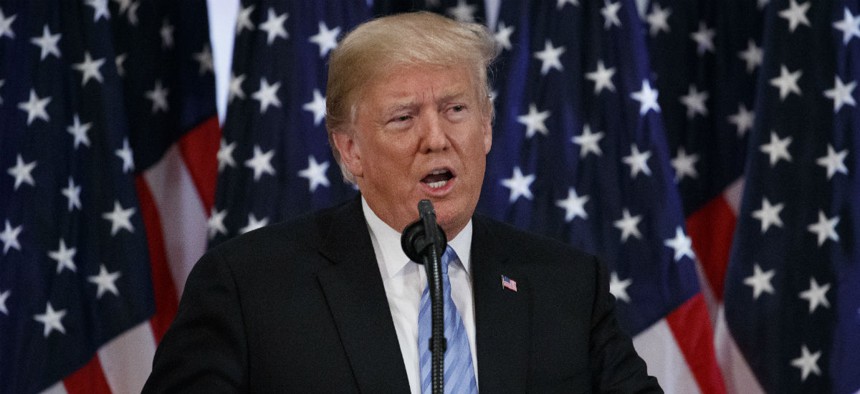
Evan Vucci / AP
Trump Signs Spending Bill to Stave Off Shutdown Until December
Congress will face a new spending deadline of Dec. 7 for agencies that don't yet have full-year appropriations.
President Trump on Friday signed into law a spending bill that will provide full-year appropriations for several federal agencies and stopgap funding for a portion of government, staving off a partial shutdown at least until December.
Trump had flirted with potentially not signing the “minibus”-plus-continuing resolution spending measure, calling the bill “ridiculous,” but ultimately opted to keep all of government open past the Sept. 30 deadline. The measure included full, line-by-line fiscal 2019 spending levels for the departments of Defense, Labor, Education, and Health and Human Services. It also included a continuing resolution to provide funding at fiscal 2018 levels through Dec. 7 for agencies that have not yet received regular appropriations. Trump has already signed into law a “minibus” bill setting spending for the departments of Energy and Veterans Affairs, as well as the legislative branch.
Without the stopgap provision included in the second minibus, unfunded agencies would have been forced to shut down on Oct. 1. Trump’s prior criticisms focused on the lack of funding for his proposed U.S.-Mexico border wall, which he would have liked to have seen before the upcoming midterm elections. He will now push for it in the lame-duck session of Congress, as the Homeland Security Department is one of the agencies that will be operating on a continuing resolution.
Trump held a closed-press signing ceremony for the bill, but subsequently released a statement. He praised the spending boost for Defense and said he was "pleased" to sign the measure into law.
"Today, I signed into law important legislation to rebuild our military, protect our communities and deliver a better future for all Americans," Trump said. He added that "radical Democrats" were refusing to "support border security and want drugs and crime to pour into our country."
Lawmakers this week boasted of their accomplishments, noting that it had been 22 years since they last successfully passed as many full-year appropriations on time. Now that Trump has signed the bill into law, the Defense Department will not be forced to operate temporarily under a CR for the first time in 10 years. The Senate last week easily approved the bill. Democrats celebrated that the final bill, which went to conference committee after the House and Senate passed their own versions of it, was stripped of “poison pill” riders and fully funded agencies over Trump’s objections.
The departments of Treasury, Commerce, Justice, Agriculture, State, Interior, Transportation, and Housing and Urban Development would join DHS and agencies such as the Environmental Protection Agency, Office of Personnel Management and General Services Administration in operating under a CR until early December. Those agencies account for just 25 percent of annual discretionary spending. Congressional negotiators are in conference over a third minibus that includes funding for Agriculture, Interior, Treasury, Transportation and HUD, as well as OPM and GSA.
That third minibus would provide the vehicle for a pay raise for the federal workforce, if lawmakers choose to provide one. The Senate version included a 1.9 percent raise for 2019, but the House remained silent on the issue, effectively supporting President Trump's pay freeze proposal. The second minibus that lawmakers sent to Trump on Wednesday budgeted for the 1.9 percent increase, but final authorization would still have to come from the third minibus. Lawmakers are not expected to vote on that bill until after the midterms. Under the Defense spending bill, members of the military will receive a 2.6 percent pay raise next year.
Lawmakers have yet to spell out a plan for how they will fund agencies beyond Dec. 7 for the remainder of federal agencies now operating under a CR, including DHS. Those negotiations are expected to take place in the lame-duck session of Congress.
This story has been updated with comment from President Trump.







